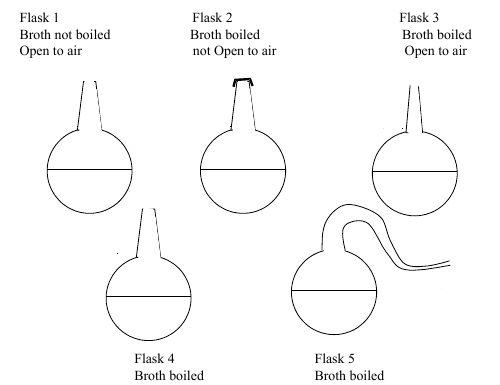1.5 The origin of cells
Evidence
All the evidence science has found points strongly to the idea that there is an unbroken chain of life from the very first cells to all of the cells found in the great diversity of organisms found today.
At one time there was a theory that life could spontaneously arise from non living matter.This was used to explain insects suddenly appearing from rotten fruit, frogs, reptiles and snakes coming out of mud and many other common observations of living things emerging from non living matter.
This theory of spontaneous generation was generally held until Pasteur performed a series of experiments to disprove the theory.
 He used the swans neck flask with boiled nutrient broth. Air could come in but no microbes. Pasteur also set up flasks of other shapes, so that he had the 5 different arrangements shown.
He used the swans neck flask with boiled nutrient broth. Air could come in but no microbes. Pasteur also set up flasks of other shapes, so that he had the 5 different arrangements shown.
Pasteurs results
Flask 1 Bacteria found immediately
Flask 2 Bacteria never found
Flask 3 Bacteria found after 5 weeks
Flask 4 Bacteria found after 1 week
Flask 5 Bacteria never found
The genetic code
A major line of evidence is that the genetic code contains 64 codons. A codon is a triplet of DNA bases that contains an instruction to join a particular amino acid into a protein chain. In the huge majority of organisms these instructions are translated in the same way. Some very small exception have evolved over the billions of years of life.
Evidence can be deduced from facts about organelles found in eukaryotic cells that suggest an origin in prokaryotic cells.
|
Mitochondria and chloroplasts have different DNA than the cells nuclear DNA |
|
Mitochondria and chloroplasts are similar in size and structure to prokaryotic cells. |
|
Mitochondria use oxygen and produce carbon dioxide whereas chloroplasts (in light conditions) produce oxygen and take in carbon dioxide. |
|
Ribosomes (70 S) in mitochondria and chloroplasts are smaller than the ribosomes (80) found in eukaryotic cells |
